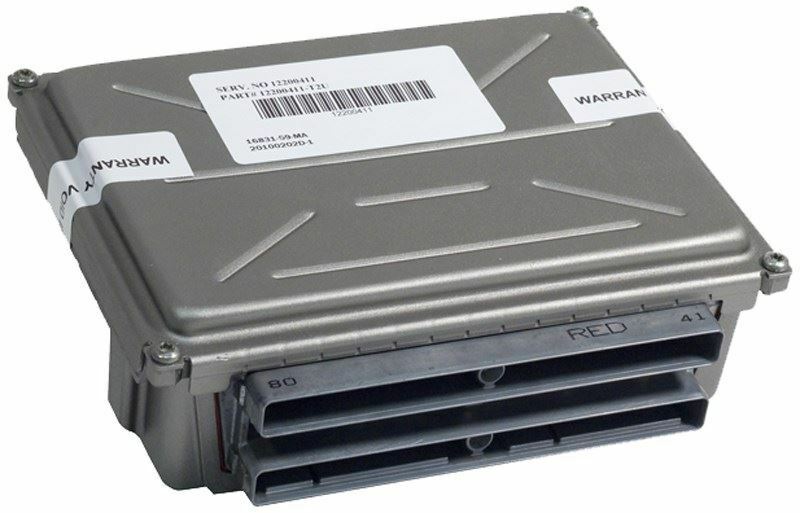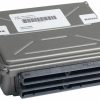Restore Peak Performance and Drive with Confidence
Is your 2004 GM truck or SUV suffering from frustrating issues like a persistent check engine light, erratic shifting, rough idling, or even a no-start condition? These are often the tell-tale signs of a failing Powertrain Control Module. Don’t let a faulty computer keep you off the road. This replacement PCM, part number 12586242, is the definitive solution to bring back the smooth, reliable performance you depend on. We take the guesswork and dealership hassle out of the equation by pre-programming the module specifically for your vehicle using your VIN. This means it arrives at your door with the latest GM software updates, ready for a straightforward installation.
Warning Signs Your PCM Needs Attention
A vehicle’s PCM is its brain, and when it starts to falter, the symptoms can be widespread. If you’re experiencing any of the following, it’s time to consider a replacement:
- ✔ Unexplained Check Engine Light (CEL) with codes like P0601, P0606, or communication errors.
- ✔ Harsh or delayed automatic transmission shifting.
- ✔ A sudden, noticeable drop in fuel economy.
- ✔ Engine stalling, stumbling, or misfiring for no apparent reason.
- ✔ The vehicle cranks but refuses to start.
- ✔ Failure to pass an emissions test due to module-related faults.
An Old Pro’s Diagnostic Tale
I remember a 2004 Silverado that came into the shop with a ghost of a problem. It would randomly stall at stoplights, but never threw a consistent code. The owner had already replaced the fuel pump and crank sensor. After checking all the usual suspects, I hooked up my scope to the PCM’s 5-volt reference circuit. Sure enough, I saw the voltage drop out intermittently. A new, properly programmed PCM fixed it instantly. The owner’s relief was palpable—he could finally trust his truck for his contracting business again. It’s not just about replacing a part; it’s about restoring that essential trust in your vehicle.
The Right Solution: A Properly Programmed 2004 Escalade ESV PCM
Choosing the right replacement is critical. This module is not just a generic part; it’s a component that will be the new nerve center of your vehicle. By providing us with your VIN, you ensure that all the specific parameters—from the engine and transmission calibration to the tire size and security system—are correctly configured. This eliminates compatibility issues and ensures your truck runs exactly as the engineers at GM intended.
Effortless Steps for a Confident Fix
You don’t need to be a master mechanic to complete this job. With basic hand tools and a little patience, you can get your vehicle back in top shape. Follow these guided steps:
- Safety First: Always disconnect the negative terminal from your vehicle’s battery and wait at least 15 minutes to allow the system to fully discharge.
- Locate the Old PCM: On most of these GM trucks and SUVs, the PCM is located in the engine bay, either on the driver’s side fender, under the battery tray, or next to the airbox.
- Disconnect the Harnesses: Carefully release the locking tabs on the electrical connectors. They can be stiff, so use gentle, steady pressure. Never pull on the wires themselves.
- Remove the Module: Unbolt the old PCM from its mounting bracket. Keep the hardware safe as you will reuse it.
- Install the New PCM: Mount your new, pre-programmed module in place and securely fasten it. Reconnect the electrical harnesses, ensuring they click firmly into place.
- Reconnect the Battery: Attach the negative battery terminal. Your vehicle is now ready to start. Note: A security relearn or CASE relearn procedure may be required with a scan tool for optimal performance.
Pro Tip: Check Your Grounds!
Before installing your new PCM, take a moment to inspect and clean the main engine and chassis ground connections. A poor ground can cause voltage issues that mimic PCM failure and can even damage a new module. A few minutes with a wire brush can save you a major headache.
Tailored Fit for Your Ride
This module is a direct replacement for service number 12586242 and is compatible with a wide range of 2004 General Motors vehicles. Please verify your part number or service ID (often found on a sticker on your current module) to ensure perfect compatibility. This part fits models with service numbers including YFKD, YFKF, YFKH, YFKJ, YFKX, YFXL, YFXM, YFXN, YFXP, and YHTN.
Compatible Models Include (but are not limited to):
- ✔ 2004 Cadillac Escalade, ESV, EXT
- ✔ 2004 Chevrolet Avalanche, Silverado, Suburban, Tahoe, SSR, Trailblazer EXT
- ✔ 2004 GMC Sierra, Sierra Denali, Yukon, Yukon XL, Envoy XL/XUV
- ✔ 2004 Hummer H2
- ✔ 2004 Buick Rainier
- ✔ 2004 Isuzu Ascender
Frequently Asked Questions
Do I need to do any programming myself?
No. We handle all the programming for you before shipment. Simply provide your vehicle’s 17-digit VIN during checkout, and the module will arrive flashed with the latest GM software specific to your truck.
What is a CASE Relearn and will I need one?
A CASE (Crankshaft Angle Sensor Error) Relearn synchronizes the new PCM with your engine’s crankshaft position sensor. While many vehicles will start and run without it, performing a CASE relearn with a capable scan tool is highly recommended to prevent a P1336 trouble code and ensure optimal engine timing and misfire detection.
Is this a simple plug-and-play installation?
For the most part, yes. Once programmed to your VIN, the physical installation is a direct swap. You disconnect the battery, unbolt the old unit, bolt in the new one, and reconnect everything. The only additional step that may be needed is the CASE relearn mentioned above.
Where do I find my vehicle’s VIN?
You can find your VIN on the driver’s side of the dashboard (visible through the windshield), on the driver’s side door jamb sticker, or on your vehicle’s registration and insurance documents.
How do I confirm this part fits my vehicle?
The best way is to match the service number (like 12586242 or YHTN) from the sticker on your current PCM. If you are unsure, please contact us with your VIN, and we will be happy to verify compatibility for you.


